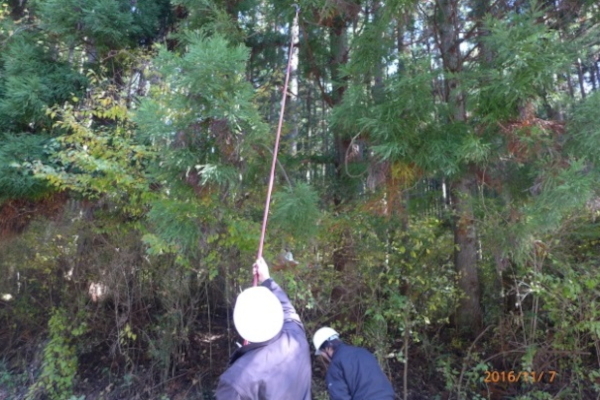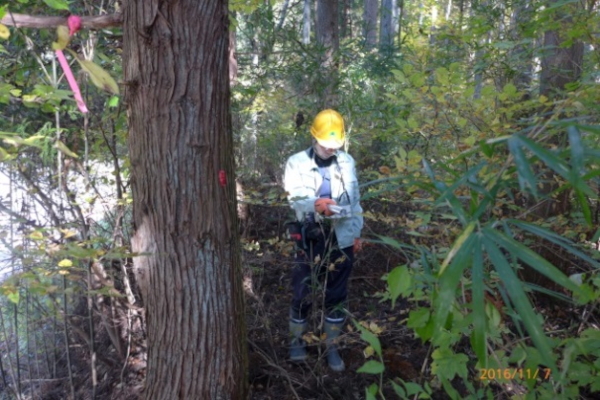Radioactivity Dynamics in forests
(2020)
QWill airborne pollen containing radioactive cesium come from forests and affect human health?
ASurveys conducted in Fukushima Prefecture show that exposure doses from the inhalation of cedar pollen containing radioactive cesium are very limited and that radioactive cesium concentrations in cedar pollen are decreasing over time.
Assuming that the highest level of radioactive cesium concentration measured in the FY 2019 survey (12.2 kBq/kg) was scattered with cedar pollen in the air and inhaled by a person, the government calculated the radiation dose of the person, using the same preconditions as in FY 2011. The estimated radiation dose was 0.0000113 µSv per hour at the maximum.
This value is very low, even when compared with 0.036 µSv per hour, the radiation dose measured in Shinjuku Ward in Tokyo on February 1, 2020.
Table 1 Estimated radiation doses received by a person, based on FY2019 survey results
| Category (preconditions) | 137Cs | 134Cs | |
|---|---|---|---|
| Radioactive cesium concentration in cedar pollen (1) | 11.3 kBq/kg | 0.9 kBq/kg | |
| Highest ever concentration of cedar pollen measured in the air (2) | 2,207 grains/m3 | ||
| Weight per cedar pollen grain | 12 nanograms | ||
| Radioactive cesium concentration in airborne cedar pollen (calculated from concentrations (1) and (2) and weight) |
0.000301 Bq/m3 | 0.000023 Bq/m3 | |
| Radiation dose received by an adult inhaling the atmosphere (calculated from concentrations (3) and (4) and weight) | Per hour | 0.0000113 μSv | |
| Total during the pollen season (February-May) | 0.0000325 mSv | ||
Source: Forestry Agency, “Results of the FY 2019 Survey on Radioactive Material Distribution in Forests”
[Past estimations (radiation dose per hour)]
H23(2011):0.000192 μSv
H24(2012):0.0000715 μSv
H25(2013):0.0000484 μSv
H26(2014):0.0000215 μSv
H27(2015):0.0000077 μSv
H28(2016):0.0000069 μSv
H29(2017):0.0000187 μSv
H30(2018):0.0000224 μSv
(Reference) The same preconditions as in FY2011 refer to the following:
(1) The radioactive cesium concentration in cedar pollen was assumed to be 12,200 Bq/kg, the highest value measured in the FY 2019 survey on male cedar flowers (on the assumption that the radioactive cesium concentration in pollen is at the same level as that in male flowers).
(2) The concentration of scattering cedar pollen in the air was assumed to be 2,207 grains/m3, the highest value measured by the Ministry of the Environment’s pollen information system.
(3) The daily volume of air inhaled by an adult was assumed to be 22.2 m3, which is provided by the International Commission on Radiological Protection. The hourly volume of air inhalation was calculated by dividing this value by 24.
(4) The effective dosage coefficient (inhalation intake) was assumed to be 0.039 μSv/Bq for Cs-137 and 0.020 μSv/Bq for Cs-134.
| Radiation dose measured in Shinjuku Ward, Tokyo (as of February 1, 2020) |
Per hour | 0.036 μSv |
Surveys in a single place in Fukushima Prefecture indicated that the cesium concentration in male cedar flowers in FY 2019 was at the same level as that in the previous fiscal year.
Related articles
- Is radioactive cesium in forests dispersed by wind? 【Near forests】
- Is radioactive cesium in forests dispersed by wind? 【Airy places】
- Will radioactive contamination continue to accumulate in reservoirs due to the inflow of radioactive cesium from rivers? 【Technology for prediction of the future concentration of 137Cs】
- Do radiation does will increase using bathing beach?
- How much did the amount or the concentration of Cs released to river water by forest fire? How did them change by time?


